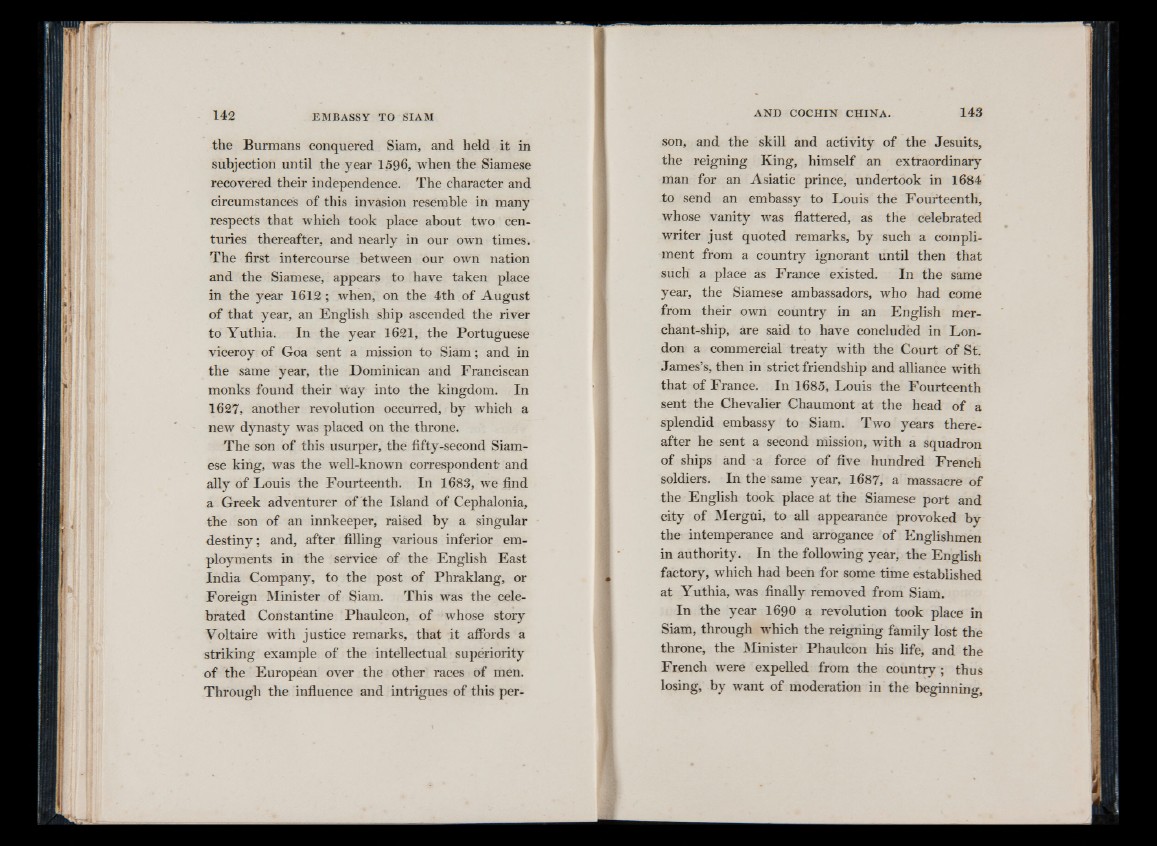
the Burmans conquered Siam, and held it in
subjection until the year 1596, when the Siamese
recovered their independence. The character and
circumstances of this invasion resemble in many
respects that which took place about two centuries
thereafter, and nearly in our own times.
The first intercourse between our own nation
and the Siamese, appears to have taken place
in the year 1612; when, on the 4th of August
of that year, an English ship ascended the river
to Yuthia. In the year 1621, the Portuguese
viceroy of Goa sent a mission to Siam; and in
the same year, the Dominican and Franciscan
monks found their wray into the kingdom. In
1627, another revolution occurred, by which a
new dynasty was placed on the throne.
The son of this usurper, the fifty-second Siamese
king, was the well-known correspondent and
ally of Louis the Fourteenth. In 1683, we find
a Greek adventurer of the Island of Cephalonia,
the son of an innkeeper, raised by a singular
destiny; and, after filling various inferior employments
in the service of the English East
India Company, to the post of Phraklang, or
Foreign Minister of Siam. This was the cele-
brated Constantine Phaulcon, of whose story
Voltaire with justice remarks, that it affords a
striking example of the intellectual superiority
of the European over the other races of men.
Through the influence and intrigues of this person,
and the skill and activity of the Jesuits,
the reigning King, himself an extraordinary
man for an Asiatic prince, undertook in 1684
to send an embassy to Louis the Fourteenth,
whose vanity was flattered, as the celebrated
writer just quoted remarks, by such a compliment
from a country ignorant until then that
such a place as France existed. In the same
year, the Siamese ambassadors, who had come
from their own country in an English mer-
chant-ship, are said to have concluded in London
a commercial treaty with the Court of St.
James’s, then in strict friendship and alliance with
that of France. In 1685, Louis the Fourteenth
sent the Chevalier Chaumont at the head of a
splendid embassy to Siam. Two years thereafter
he sent a second mission, with a squadron
of ships and -a force of five hundred French
soldiers. In the same year, 1687, a massacre of
the English took place at the Siamese port and
city of Mergui, to all appearance provoked by
the intemperance and arrogance of Englishmen
in authority. In the following year, the English
factory, which had been for some time established
at Yuthia, was finally removed from Siam.
In the year 1690 a revolution took place in
Siam, through which the reigning family lost the
throne, the Minister Phaulcon his life, and the
French were expelled from the country; thus
losing, by want of moderation in the beginning,